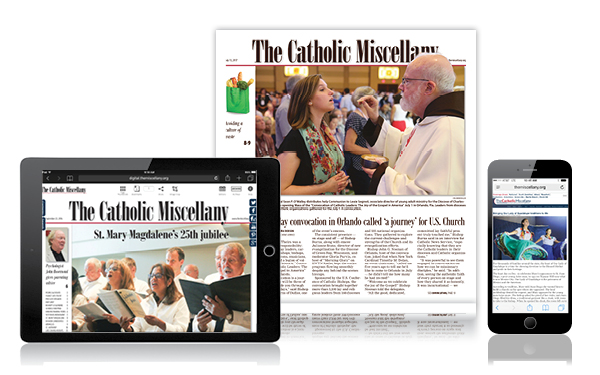
CHARLESTON—In the summer, The Catholic Miscellany will become a magazine, making the paper edition of April 8 the last newspaper for the Diocese of Charleston.
The new magazine will launch in June and be published monthly. It will focus on feature length articles designed to evangelize and teach the faith. Diocesan news coverage will then move to The Miscellany’s website. Bishop Robert E. Guglielmone approved the decision for the switch late in 2020 after consultation with the presbyteral council.
The upcoming metamorphosis is not a new concept for what was the first Catholic newspaper to be published in the United States. When Bishop John England first took pen to paper, writing in defense of the faith in a land hostile to Catholics, he used whatever means necessary to get the word out. He arrived in Charleston in 1821 and began distributing his writings on June 5, 1822. He had to buy advertisement space in either the Charleston Mercury or the Charleston Courier to answer nativist attacks. Nativism was a movement that sought to restrict the political rights of foreign-born citizens, particularly the Irish immigrants.
Bishop England’s intent was to provide weekly written instruction of Catholic doctrine through essays and to correct falsehoods circulated by anti-Catholic entities. He dubbed it the United States Catholic Miscellany and it became a successful mouthpiece for the Church.
Brian Fahey, director of the Office of Archives and Records Management for the diocese, said the original iteration published on the diocese’s own printing press was in pamphlet form and covered the Church in the U.S. It included marriages and deaths of Catholic laypeople from as far as the Archdiocese of New Orleans as well as advertising for school enrollment.
Bishop England excelled at apologetics, and was very diplomatic, Fahey said. Though the average Catholic may not have read what he wrote, Fahey said the bishop’s contemporaries would have.

The bishop would engage the local press. Sometimes he would use a nom de plume when writing in other publications.
Though media is changing with more people reading information online than in print, Fahey said Bishop England’s newspaper is absolutely relevant today.
“Bishop England was way ahead of his time, he was radical for his time. He believed in the representation of the people. To actually engage somebody outside of the Church and debate with them was radical. He did it outside of the Church, of course, but engaged them nonetheless,” Fahey said.
After the fire of Dec. 11, 1861, on the Charleston peninsula destroyed the Cathedral of Saint John and Saint Finbar, the editorial offices of the paper and its press, The Miscellany stopped publishing for a time. Eventually, Bishop England worked with a local printer to publish pamphlets, letters and speeches for special occasions.
While Bishop England was a great orator, he was not an administrator, so his first editor was Father Patrick N. Lynch, who became bishop after Bishop Ignatius A. Reynolds. The original circulation was in the hundreds and the cost was only $4, which few ever paid. Fahey said a good deal of editorial space was devoted to encouraging people to pay their subscription fees.
In addition to format, the name of the paper has changed over the years, reflecting current events and the focus of the episcopacy at the time. Those names included U.S. Catholic Miscellany, which for some became politically charged and changed to the Charleston Catholic Miscellany, arguably reflecting South Carolina’s succession from the union or the establishment of a separate diocese for Georgia.
With ebbs and flows of publication, The Miscellany may have been the first Catholic newspaper in the U.S. but it was not a continual one.
In 1951 local news was resurrected under The Catholic Banner and was a section of Our Sunday Visitor. In 1960, The Banner became part of a three-diocese consortium, designed and published in Waynesboro, Ga., with some local articles and photographs accompanying national and international stories from Catholic News Service.
Bishop David B. Thompson returned the diocesan newspaper to its historic roots in 1990, renaming it The New Catholic Miscellany. Production moved from Columbia to Charleston in 1995, and the staff began producing the paper in-house and printing it locally.
In 2002, the word New was dropped from the nameplate and the paper became The Catholic Miscellany. It underwent design changes in the process, but the focus remained on providing Catholics in South Carolina with local news and articles that were catechetically based.
